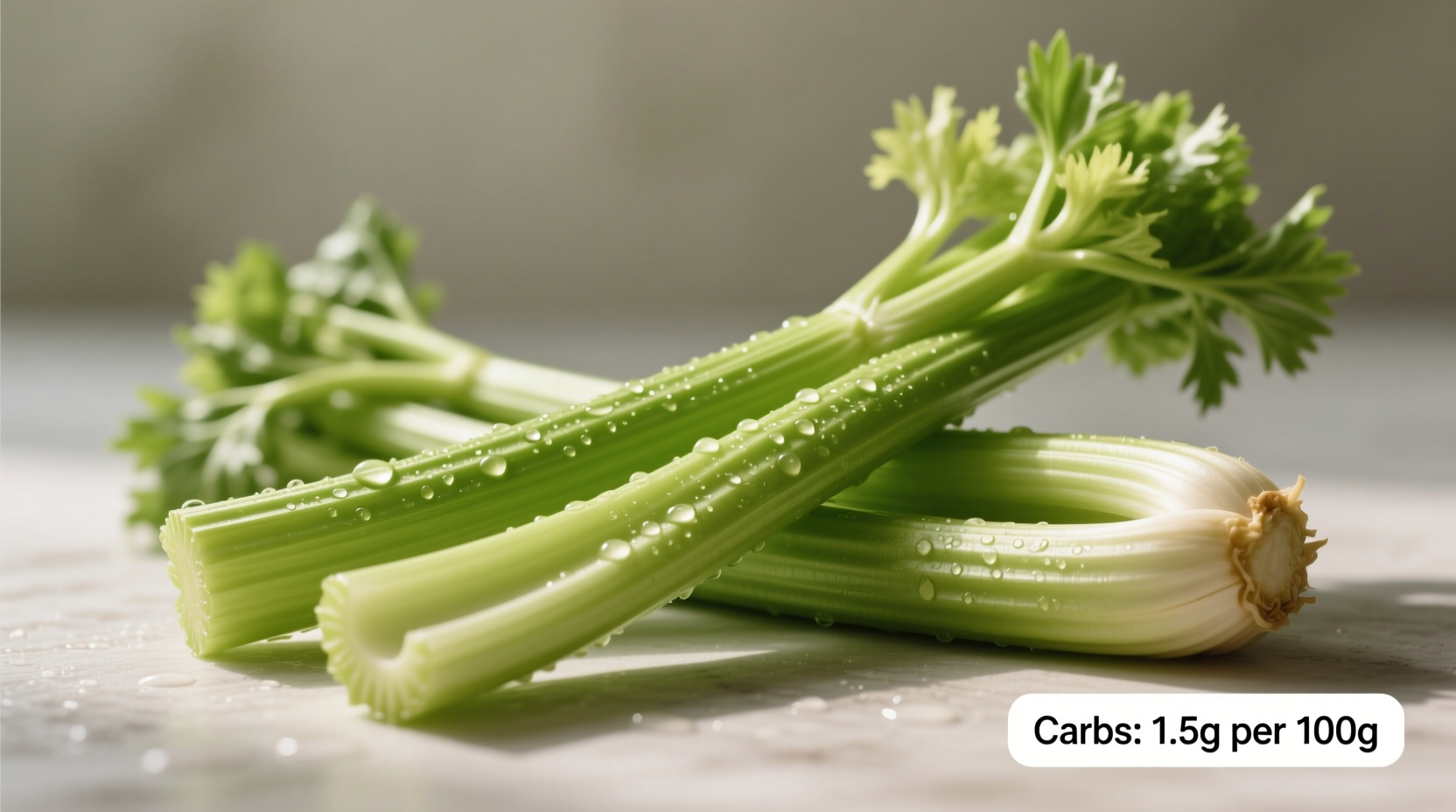When tracking your carbohydrate intake, understanding the precise nutritional profile of common vegetables is essential. Celery stands out as an exceptionally low-carb option that provides hydration, fiber, and essential nutrients without significantly impacting your daily carb count. Whether you're following a strict ketogenic diet, managing blood sugar levels, or simply looking to incorporate more nutrient-dense vegetables into your meals, celery offers remarkable versatility with minimal carbohydrate contribution.
Understanding Celery's Nutritional Profile
Celery's reputation as a "negative calorie" food stems from its extremely low energy density and high water content. Scientific analysis reveals why this humble vegetable deserves a place in various dietary approaches. According to the USDA FoodData Central database, the standard nutritional breakdown per 100g of raw celery is remarkably consistent across multiple studies.
| Nutrient | Per 100g | Per Medium Stalk (40g) | Per Cup Chopped (100g) |
|---|---|---|---|
| Total Carbohydrates | 2.97g | 0.96g | 3g |
| Dietary Fiber | 1.6g | 0.6g | 1.6g |
| Net Carbs | 1.37g | 0.36g | 1.4g |
| Water Content | 95.43g | 38.17g | 95.43g |
| Calories | 16kcal | 6kcal | 16kcal |
Data source: USDA FoodData Central, National Nutrient Database for Standard Reference
How Celery Fits Into Low-Carb Dietary Approaches
For individuals following ketogenic diets that typically restrict net carb intake to 20-50g daily, celery represents an excellent vegetable option. With only 0.36g net carbs per stalk, you could consume multiple stalks without significantly impacting your daily carb allowance. The fiber content in celery also contributes to digestive health without affecting blood glucose levels, making it suitable for those managing diabetes.
Registered dietitians often recommend celery as a crunchy, satisfying snack for people monitoring carbohydrate intake. Its high water content promotes hydration while providing essential electrolytes like potassium and magnesium. The natural sodium content in celery (about 80mg per stalk) can be beneficial for those following very low-carb diets who need to maintain electrolyte balance.

Celery Compared to Other Common Vegetables
When evaluating vegetables for low-carb eating, understanding relative carbohydrate content is crucial. Celery consistently ranks among the lowest-carb vegetables available. This comparison helps contextualize where celery stands among other popular vegetable choices:
- Celery: 0.36g net carbs per stalk (40g)
- Cucumber: 1.2g net carbs per 100g
- Zucchini: 2.1g net carbs per 100g
- Spinach: 0.9g net carbs per 100g
- Broccoli: 4.0g net carbs per 100g
- Carrots: 6.0g net carbs per 100g
This significant difference explains why celery is frequently recommended over higher-carb vegetables when strict carbohydrate restriction is necessary. The comparison becomes even more pronounced when considering typical serving sizes—most people consume larger volumes of celery than carrots in a single sitting.
Practical Applications for Low-Carb Eating
Incorporating celery into your daily meals requires minimal planning due to its versatility and neutral flavor profile. Here are evidence-based usage recommendations from nutrition professionals:
- Snacking: Enjoy celery sticks with nut butter or cheese for a balanced snack with minimal carb impact
- Flavor Base: Use celery as part of mirepoix (with onions and carrots) in small quantities for soups and stews
- Hydration Boost: Add chopped celery to water for subtle flavor without significant sugar content
- Salad Component: Combine with leafy greens and high-fat dressings for a satisfying low-carb salad
- Vegetable Substitutes: Use celery ribs as "noodles" in place of higher-carb pasta alternatives
Professional chefs often utilize celery's natural crunch and mild flavor to add texture to dishes without overwhelming other ingredients. The fibrous nature also helps create satisfying mouthfeel in low-carb preparations where texture variety might otherwise be limited.
Common Misconceptions About Celery Carbs
Despite its reputation as a low-carb vegetable, several misconceptions persist about celery's carbohydrate content. Understanding these clarifications can help you make more informed dietary choices:
Some believe celery contains zero carbs, but all plant-based foods contain some carbohydrates. The amount in celery is simply very low. Others mistakenly think celery has negative calories, suggesting your body burns more calories digesting it than it provides. While celery is extremely low in calories, the thermic effect of food doesn't actually create a calorie deficit.
Another common misunderstanding involves celery juice. When juiced, celery loses its valuable fiber content while concentrating the natural sugars. One cup of celery juice contains approximately 5g total carbs compared to 1.4g in chopped celery, significantly increasing its carbohydrate impact.
Scientific Context of Celery's Carbohydrate Composition
Celery's carbohydrate profile consists primarily of structural polysaccharides that form its fibrous nature. These include cellulose, hemicellulose, and pectin—components that humans cannot fully digest but that provide important prebiotic benefits. The small amount of simple sugars present (glucose, fructose, and sucrose) accounts for the minimal net carb count.
Research published in the Journal of Agricultural and Food Chemistry confirms that celery's carbohydrate composition remains stable across different growing conditions and varieties. This consistency makes it a reliable option for those who need to track carb intake precisely. Unlike starchy vegetables whose carb content can vary significantly based on growing conditions, celery maintains its exceptionally low-carb profile regardless of cultivation method.
When Celery Might Not Be Ideal
While celery is generally well-tolerated, certain dietary contexts require consideration. Individuals following extremely low-FODMAP diets for IBS management may need to limit celery, as it contains mannitol, a sugar alcohol that can trigger symptoms in sensitive individuals. The Monash University Low FODMAP Diet app lists celery stalks as low-FODMAP in servings up to 75g (about 1.5 stalks), but celery leaves contain higher FODMAP levels.
Those with specific allergies to celery (more common in Europe than North America) should obviously avoid this vegetable. Additionally, individuals on blood thinners should maintain consistent vegetable intake rather than dramatically increasing or decreasing celery consumption, as it contains vitamin K which affects coagulation.
Maximizing Celery's Nutritional Benefits
To get the most nutritional value from celery while maintaining its low-carb properties, consider these evidence-based preparation tips:
- Leave the leaves intact when possible—they contain higher concentrations of vitamins and antioxidants
- Store celery in water in the refrigerator to maintain crispness and nutrient retention
- Pair with healthy fats like olive oil or avocado to enhance absorption of fat-soluble nutrients
- Avoid overcooking, which can reduce nutrient content and increase the glycemic impact slightly
- Use the entire stalk, including the tougher outer ribs, which contain the highest fiber content
Recent research from the Harvard T.H. Chan School of Public Health emphasizes that consuming whole vegetables like celery provides more health benefits than isolated components. The synergistic effect of fiber, phytonutrients, and minimal natural sugars in celery creates a nutritional package that supports metabolic health beyond what the simple carb count suggests.
Frequently Asked Questions
How many carbs are in one stalk of celery?
One medium celery stalk (approximately 40g) contains 0.96g total carbohydrates, with 0.6g fiber and 0.36g net carbs. This makes celery one of the lowest-carb vegetables available for those monitoring their carbohydrate intake.
Is celery suitable for a keto diet?
Yes, celery is excellent for keto diets due to its extremely low net carb content (0.36g per stalk). You can consume multiple stalks without significantly impacting your daily carb limit, making it a versatile vegetable option for maintaining ketosis while adding fiber and nutrients to your diet.
Does celery juice have the same carb count as whole celery?
No, celery juice has a higher carb concentration than whole celery. When juiced, celery loses its valuable fiber content while concentrating the natural sugars. One cup of celery juice contains approximately 5g total carbs compared to 1.4g net carbs in one cup of chopped celery, making whole celery the better choice for strict carb counting.
How does celery compare to other low-carb vegetables?
Celery ranks among the lowest-carb vegetables available. With only 0.36g net carbs per stalk, it contains significantly fewer carbs than vegetables like zucchini (2.1g/100g), broccoli (4.0g/100g), or carrots (6.0g/100g). Only vegetables like iceberg lettuce and certain leafy greens have comparable or slightly lower carb counts per serving.
Can people with diabetes eat celery?
Yes, celery is an excellent vegetable choice for people with diabetes. Its minimal net carb content (0.36g per stalk) has negligible impact on blood sugar levels. The fiber content also helps slow glucose absorption, and celery's high water content promotes hydration, which is particularly important for diabetes management. Most diabetes nutrition guidelines recommend celery as a safe, low-impact vegetable option.











 浙公网安备
33010002000092号
浙公网安备
33010002000092号 浙B2-20120091-4
浙B2-20120091-4